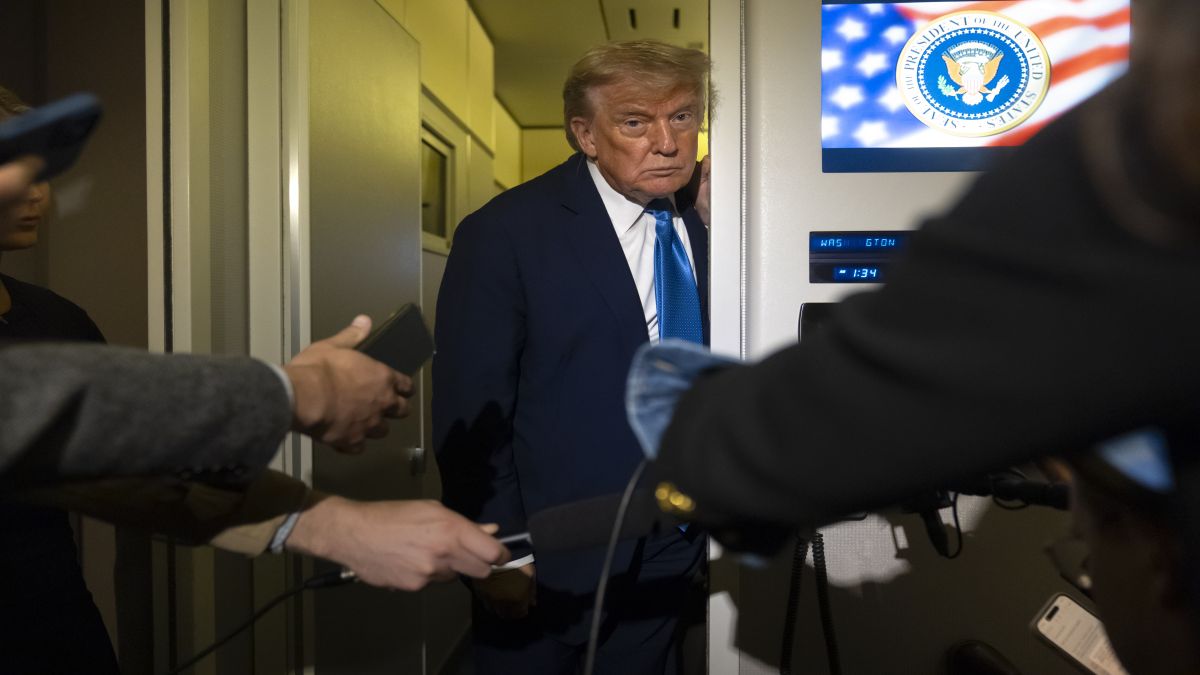It’s been almost a week since tensions between Israel and Iran escalated — military and residential sites have been pummelled and the death toll keeps mounting on both sides. But on Wednesday, the biggest bomb (not an actual one) was lobbed by US President Donald Trump when he called for Iran’s “unconditional surrender”.
Trump made a series of comments that signalled America’s possibility of entering the war just a day after he left the G7 summit in Canada early to focus on the war. The US president’s latest comments on the Israel-Iran conflict is part of his mixed messaging about what he wants from Iran and just how involved the United States is or will be.
But what has Trump now said? What does it mean for the ongoing Israel-Iran conflict? We try to decode it all.
Trump’s ‘unconditional surrender’ call to Iran
On Tuesday (June 17), Trump escalated his rhetoric against Iran, issuing a threat on social media against its Supreme Leader Ayatollah Ali Khamenei and taking credit for having “complete and total control of the skies over Iran”.
“We know exactly where the so-called ‘Supreme Leader’ is hiding. He is an easy target, but is safe there – we are not going to take him out (kill!), at least not for now. But we don’t want missiles shot at civilians, or American soldiers. Our patience is wearing thin. Thank you for your attention to this matter!” Trump posted on his social media platform Truth Social.
He followed up with a second post a few minutes later, writing: “UNCONDITIONAL SURRENDER!”
Interestingly, these strong messages from the US president came just a day after he cut short his G7 visit to Canada and on his way back to Washington warned “everyone in Tehran to evacuate”.
After US President Donald Trump’s stern warning, Iran’s Supreme Leader Ayatollah Ali Khamenei responded with a post of his own, “In the name of the noble Haidar, the battle begins.”
Trump mulling to join the conflict
According to several news reports, Trump’s increasingly muscular comments against Tehran are an indicator of deepening American involvement in the West Asian crisis perhaps by providing the Israelis with bunker-busting bombs to penetrate Iranian nuclear sites built deep underground or offering other direct US military support.
The New York Times has reported that Trump is weighing whether to use B-2 aircraft to drop bunker-busting bombs on Iran’s underground nuclear facilities.
Notably, Trump held an emergency meeting in the Situation Room of the White House. The meeting, which lasted an hour and twenty minutes, was held to discuss whether the US should join Israel to strike Iranian nuclear sites. As per a CBS news report, there isn’t a full agreement among Trump’s closest advisors.
Moreover, the US is deploying more fighter aircraft to West Asia and extending the deployment of other warplanes. The deployments include F-16, F-22 and F-35 fighter aircraft. A US defence official also added that the Pentagon was redeploying the USS Nimitz aircraft carrier strike group to West Asia “to sustain our defensive posture and safeguard American personnel”.
However, experts note that America’s direct involvement in the conflict is a “scary proposition”. US involvement would completely change the way the war is being waged by Iran,” said Dr Dara Conduit, a fellow and lecturer in political science at the University of Melbourne, to BBC. “It would remove any ability for Iran to back down,” she said, adding that Iran would be forced into attacking US interests in West Asia.
Trump’s mixed messages on Israel-Iran conflict
For many watchers of the Israel-Iran conflict, Trump’s comments on Tuesday are part of his ongoing mixed messaging. As Shira Efron, director of research at Israel Policy Forum, a New York-based research group, told the New York Times, “It’s very puzzling. “You’re seeing him say one thing and then another.” Meanwhile, Sky News in an analysis noted that the latest remarks by the US president are an extreme version of maximum pressure diplomacy.
For instance, on Friday, the first day of the war, Trump initially called Israel’s attacks “excellent” and “very successful,” but also said that he believed a diplomatic solution between Israel and Iran was possible.
Then days later, on June 15, Trump said Iran would “like to make a deal. They’re talking. They continue to talk.” And on the following day during his visit to Canada for the G7 Summit, he told reporters that Iran was “basically at the negotiating table. They want to make a deal. And as soon as I leave here we’re going to be doing something.”
However, that quickly changed and on early Tuesday, he suggested that negotiations were going nowhere. “They should have done the deal,” Trump said on Air Force One on his way back from Canada. “I told them, ‘Do the deal.’ So I don’t know. I’m not too much in the mood to negotiate.”
Moreover, the Israel-Iran conflict and America’s direct involvement has also led to deep divisions within Trump’s core support base . Individuals such as former news anchor Tucker Carlson have urged that Washington doesn’t enter this fight to which Trump responded, “Somebody please explain to kooky Tucker Carlson that, ‘Iran can not have a nuclear weapon’.”
But Trump’s second, Vice President JD Vance, has defended the US president’s Iran policy. He said Trump “may decide he needs to take further action to end Iranian enrichment,” but that he is “only interested in using the American military to accomplish American people’s goals.” He reiterated that Iran “can’t have a nuclear weapon.”
With inputs from agencies


)

)
)
)
)
)
)
)
)



